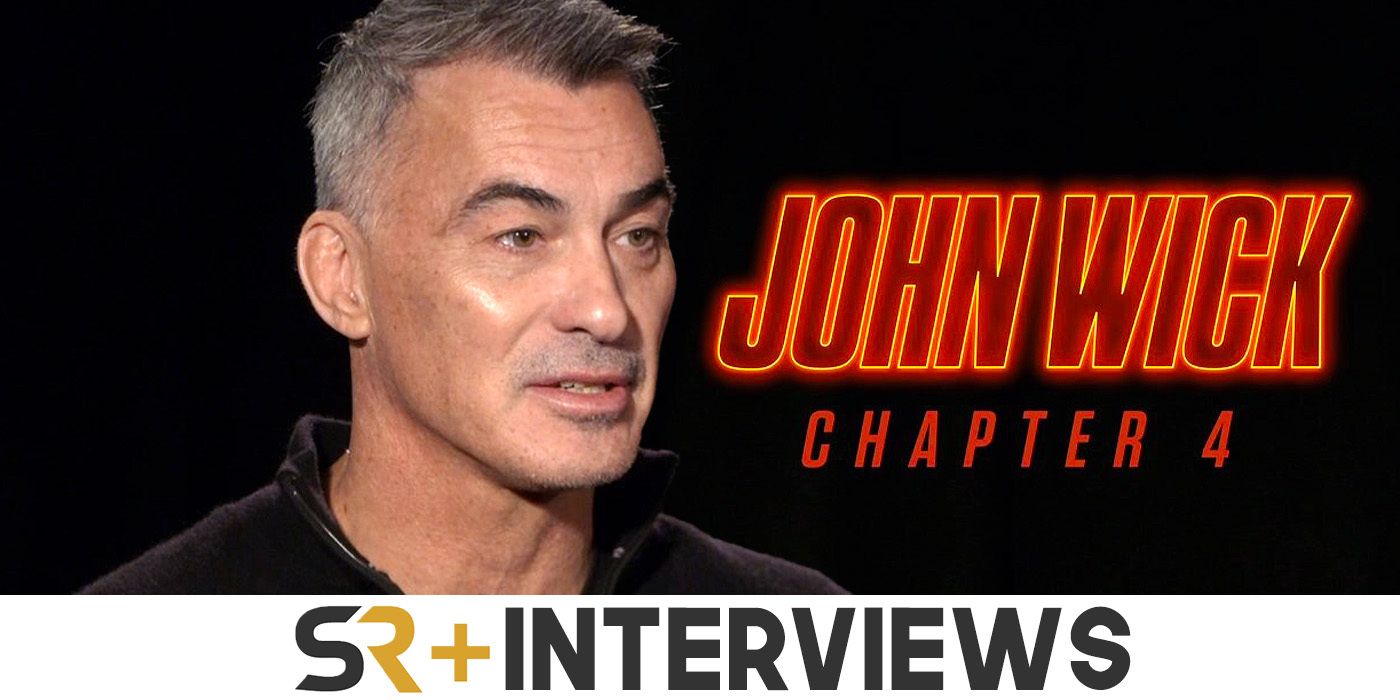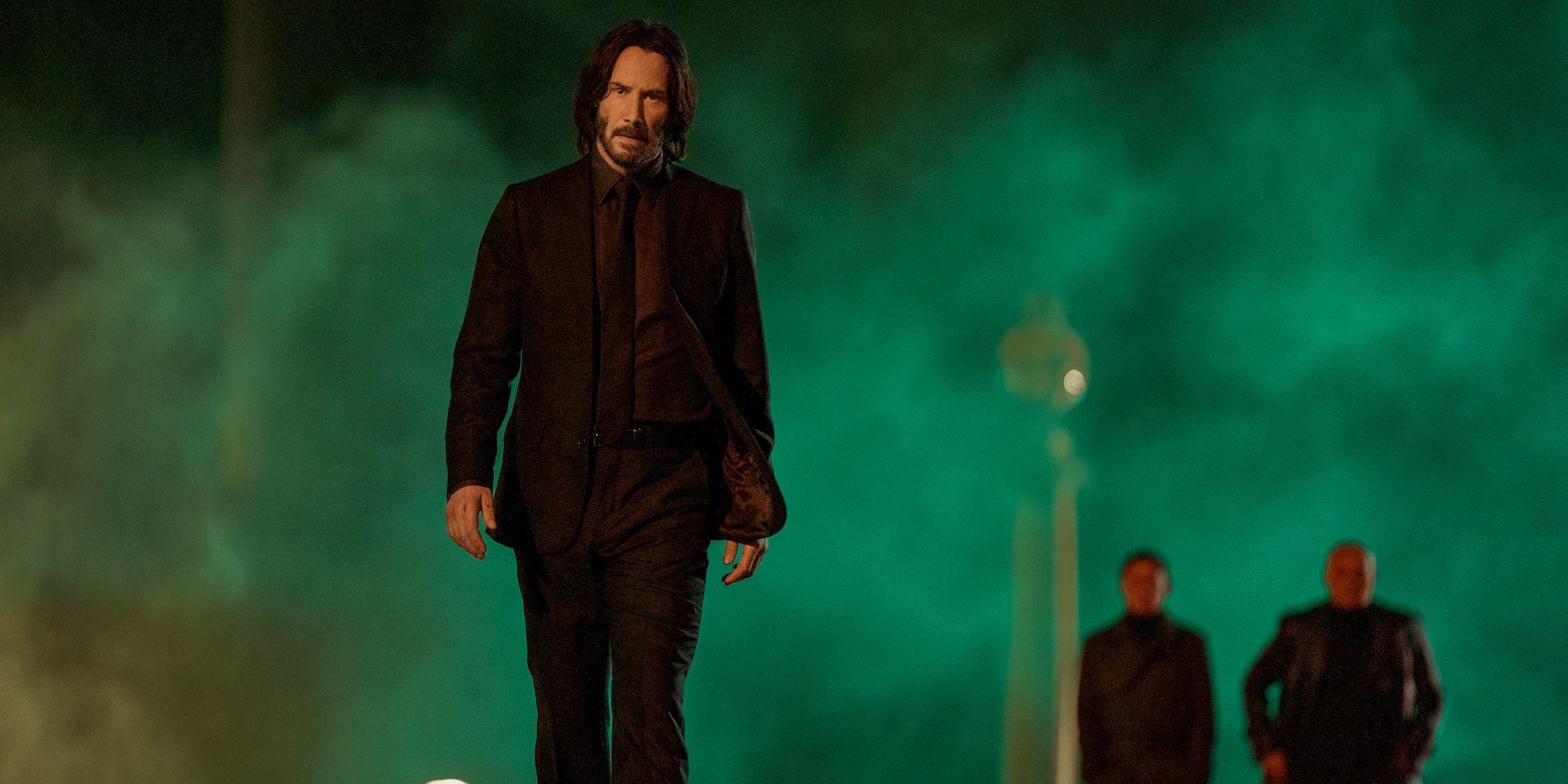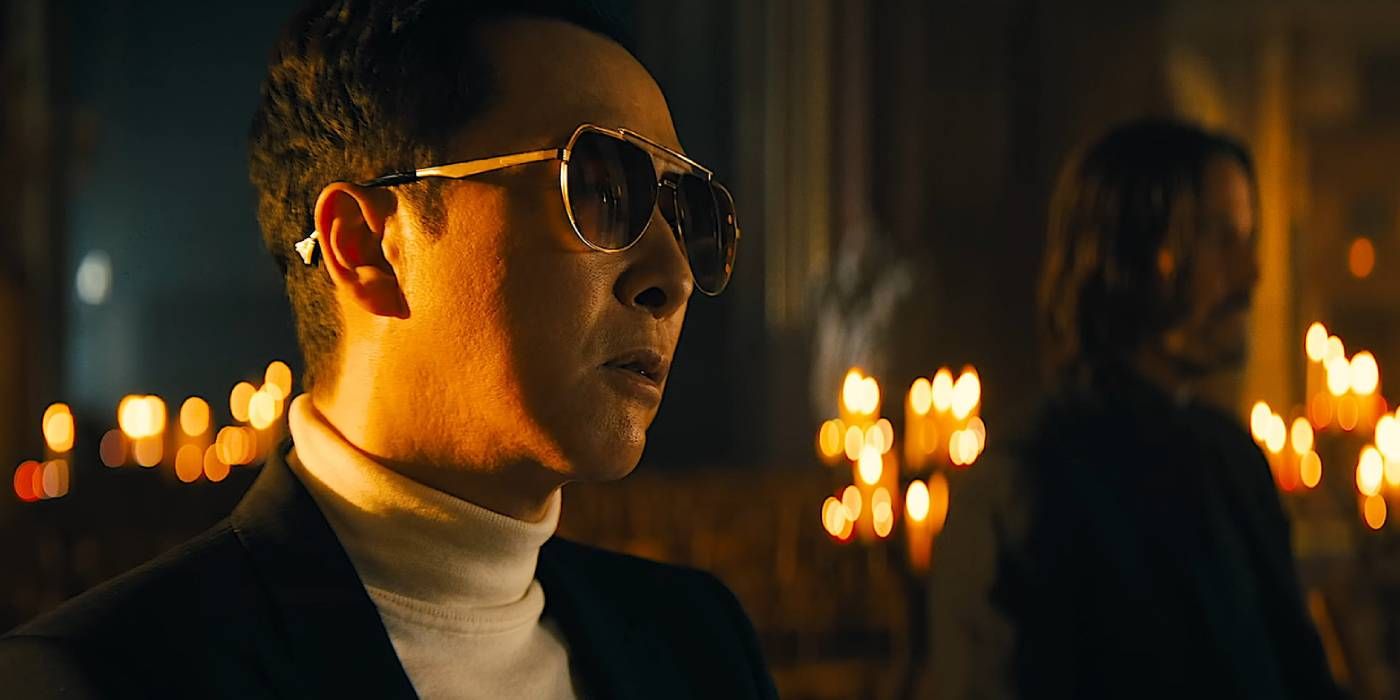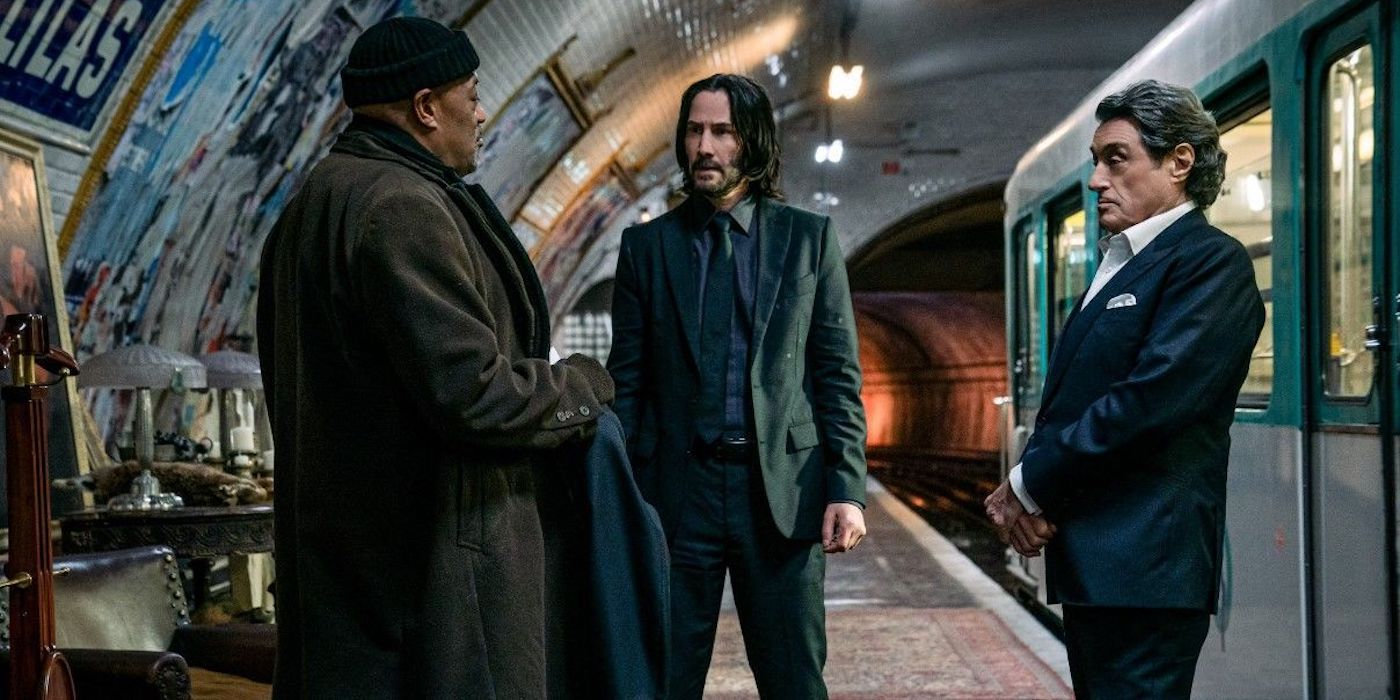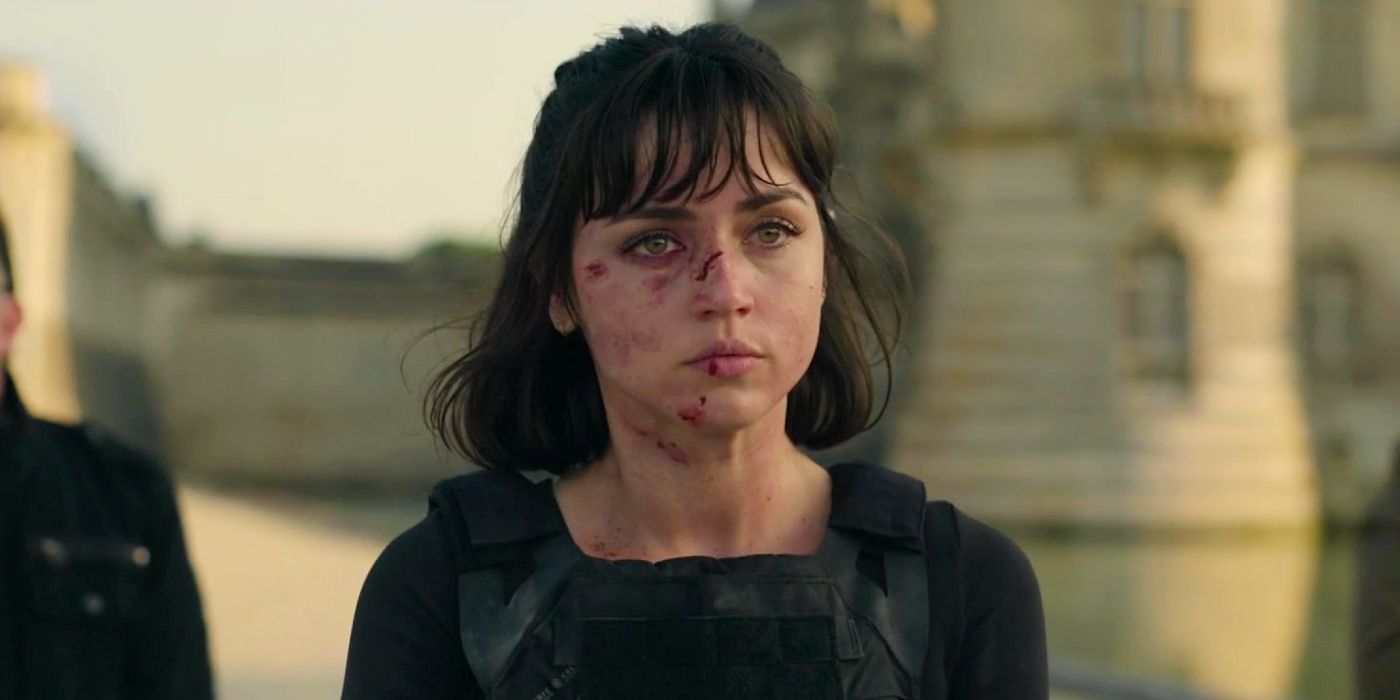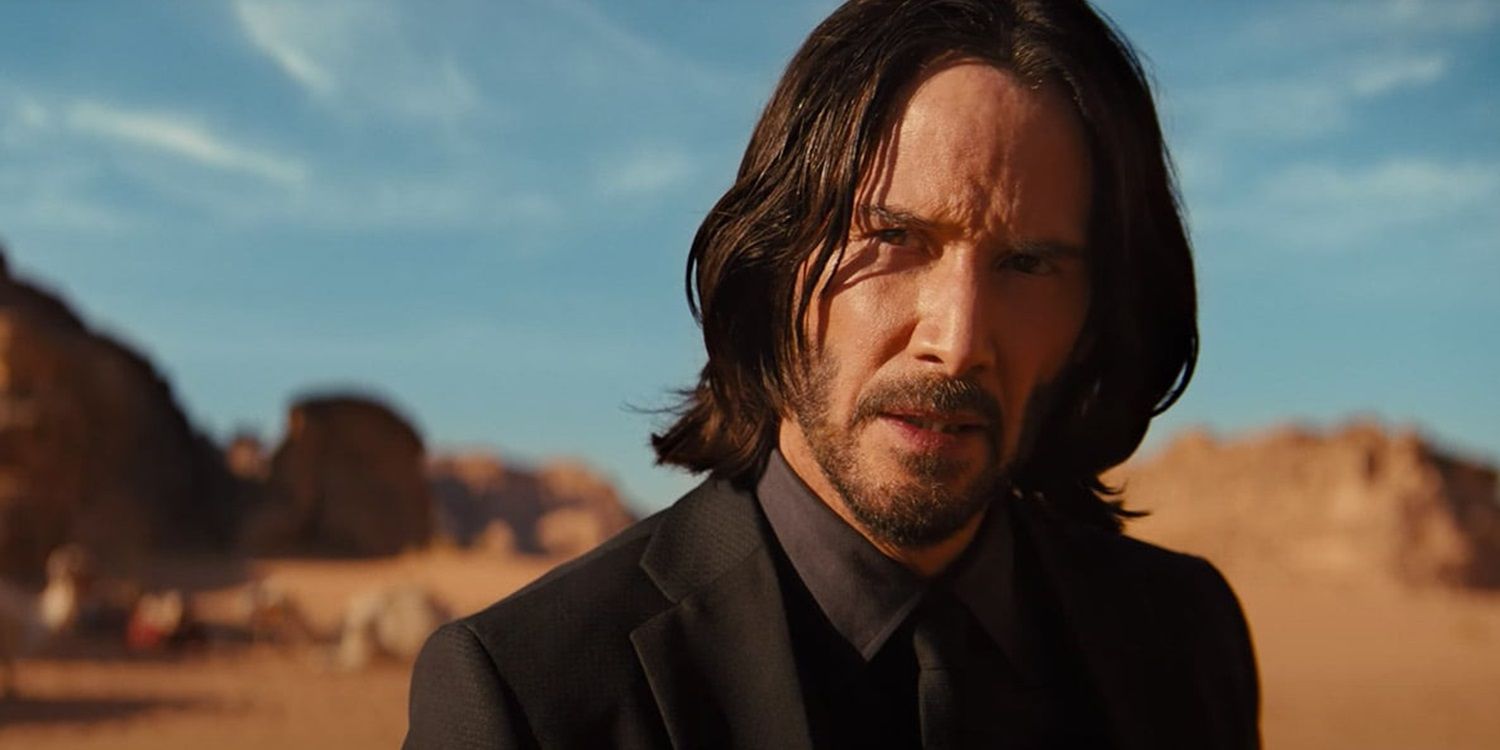Warning: SPOILERS for John Wick: Chapter 4!
John Wick is on the hunt for the High Table cutting a new path to take them down and earn his freedom in John Wick: Chapter 4. When a new enemy is sent by the High Table, the Marquis Vincent de Gramont, allies become targets and old friends become adversaries. John Wick's mission becomes more challenging and personal than ever as he races to destroy the people who are out for his blood.
Director Chad Stahelski returns to helm John Wick: Chapter 4 with a star-studded returning cast led by Keanu Reeves, Laurence Fishburne, Ian McShane, and the late Lance Reddick. Joining the world of John Wick is an impressive cast, including Donnie Yen, Bill Skarsgård, Hiroyuki Sanada, Shamier Anderson, Rina Sawayama, Scott Adkins, and Clancy Brown. The world of John Wick continues to grow with Ballerina and The Continental, but John Wick: Chapter 4 shocked audiences with the final moments of the film, which will be delved into throughout this interview.
Director Chad Stahelski spoke with Screen Rant about John Wick: Chapter 4. He broke down the shocking John Wick: Chapter 4 ending and contemplated what a John Wick: Chapter 5 would look like now. Stahelski also shared the story of how he got involved with Reeves on the first John Wick and revealed which action stars he wants to bring into the franchise in the future.
Chad Stahelski on John Wick: Chapter 4's Ending & More
Screen Rant: One thing I love about John Wick is the way that we explore his past is through his relationships rather than flashbacks. Can you talk to me about that?
Chad Stahelski: I think it's just a narrative style or storytelling technique, I guess you could say, but you kind of hit it right off the bat. You said it better than I could; you explore John Wick's past through his relationships. The first movie is always the best example because you killed his dog. We didn't know if that was going to work. We just decided that one of the things David Leitch, Keanu and I never really loved about action movies was exposition. "We hate exposition. Do we have to do exposition?" Because, believe me, in the original script there was a scene where people explained John Wick's past. We were like, "That's the first right thing that's got to go," and we've kind of lived by that.
First of all, we always thought there'd be just one, so we didn't think we'd have to sustain it. We were trying to be new filmmakers and just go, "F--k it, no exposition!" Now we're like, "Wow, I really wish maybe we kept a little exposition." We have to keep coming up with new ways to do it.
You've done all of these John Wick movies, and this is some of the best action in cinema. But also the camerawork is innovative and phenomenal. Can you talk to me about you've progressed as a director in these four movies?
Chad Stahelski: Yeah, the best way I can say it is that we all try to get better every day. The more articles you write, the better you get, right? I hope you don't go the other way. And I think, in the middle of writing articles, you're reading books. Every little thing inspires you; you watch somebody's documentary, or you read somebody else's review, and you go, "That's cool," and you expand. You get better during your writing process, but it's also the in between where you really expand because you get more inspired.
It's no different from us. The first one is your first time directing, so you have all these grandiose ideas, but you have a limited budget and time. You try to make a statement, and you try to have some kind of authorship over whatever your style is. But it's your first film, so you take a stab. You know that you want anamorphic, you know you want lens flares on a certain color palette. You want to break the mold a little bit, but at the same time, you've got no time or money, but you're trying to do a Gene Kelly movie with martial arts.
The second one, I had more money and more time, so I wanted to do a rock opera. You have a big concert and Caracalla baths in Rome, and now you're exploring yourself. It was probably around the third film, where I had taken time to really understand that directing is a little different than I thought it was. I looked at Keanu and was like, "I gotta get really better at this. How do you do this? I gotta be better at storytelling. I gotta write this thing better." I'm a little weak in my second acts; I got a great opener, and I can end 'em good, but my second act is a little squishy. What is John Wick really doing? "He's killing people." That's not good enough.
You come to the fourth one, and now I've spent seven years directing John Wick, researching storytelling, and reading as much as I can and trying things. For the first time, I feel like I've got a story. I'vee got my head around storytelling now. To answer your question, it's a learning process. You see how hard my stunt team work, and you see how Keanu works. It's all hanging on him, right? I pushed my crew and all this stuff, and now I've got John Wick 4. I've got this story that I really want to tell in a narrative way that I want to tell it, and I need 100 days and nights, and I'm going to push Keanu at 57 even more than I've ever pushed him before.
So, how do you think I have to look myself in the mirror and go, "Well, if I'm not better, I'm going to let my crew and my cast down." You really take that beat and go, "Okay, I gotta get my s--t together." You watch these films and really be honest with yourself what you're good at and what you're not good at. I realized what I was not good at, and Keanu and I and the crew realized what we were really successful at and what we're lacking. Everybody went, "Okay, hands in. Let's promise to get better at what we're not good at." What do I suck at? I gotta improve my narrative. I gotta improve my storytelling.
What's more interesting? It's not just come up with a gag or camera angle; it's just making yourself better. If I get better, Keanu gets better, the crew gets better, and the movie gets better. It's that f--king simple. If you rely on a bigger explosion or a bigger gag or some funky camera angle, that will sustain you for a beat. But that's an enormous boost; that's not a meal. You've got to become a better chef and get better product to make a better meal, and that's just the attitude we took.
Thank you for that insight. They just keep getting better and better. I'm a fan of John Wick, and I love the lore. What lore can they fans look forward to in John Wick: Chapter 4?
Chad Stahelski: Hopefully what we were just talking about. It's evolutions; Keanu wanted to give more and expand more. It's not that we get bored, but we want to expand. We're audience members too, and we're trying to make the movie that we'd like to see. You want to see ninjas on motorcycles? I do. I want to see some Greek myth and a modern day Lord of the Rings fantasy-esque world where there's duels and Kung Fu.
We're doing brands on our arms, and I want to know what a crest is. I want to know what this ritual is. We love etiquette and ritual, and all these little tidbits. Plus we get to drive 71 Barracudas through traffic. I'll go see that movie! Again, we make these huge lists in John Wick of what we love about movies and what we'd like to see, and then we try to make a story around it.
I really love that final scene. It felt to me almost like a Samurai film. What inspired that?
Chad Stahelski: Very Zatōichi . Very Kurosawa. I'm a huge fan of Westerns and Samurai films. How can you not see it in the movies? Whether it's [Sergio] Leone or John Ford, or whether it's Kurosawa or Shintaro Katsu ... Whatever you want to say.
In the early John Wicks, you can see there's always an etiquette; there's ceremony. I believe in ceremony and etiquette and rituals. That's why you see so many crests and markers and things. There's something interesting to me about that. To make it so personal, it has two friends duel for different reasons, by proxy or by first person. That's a dilemma. That's the most existential dilemma you can have.
You have someone you care about, and it's a choice. It's either, "I have to die to let him live, or live and let him die." How do I feel about both? But then you add in the next thing, "I'm living for myself." John has to make a choice. It's not about him and Caine, it's about Caine living for something more important than either of them. That's an interesting dilemma to figure out. That was not an easy thing on paper to go, "That makes sense." You can't just say, "I'm going to live or die for your reason." But I think you get that right in the scene, and that's the interesting thing to really put together.
It was that one little piece of the puzzle that pretty much locked Keanu and I in. You can't just go, "I'm going to kill off my lead. I'm going to not kill off my lead. I'm going to be subversive and make you think I killed off my lead." That's not the point. The point is choice. John made a choice to do something bigger than himself, or to save someone else that was not even in the movie. That's interesting to me.
John Wick 4 and 5 were originally supposed to shoot back-to-back. What would John Wick: Chapter 5 look like now?
Chad Stahelski: God, to be honest with you, I don't know. Not to cause any weird clickbait or anything like that, the studio first came to us and went, "Look, we would like to explore the option of doing 4 and 5 together." And the daunting-ness of that at first is a little intimidating, [but] it's also incredibly flattering. I an industry where everyone's trying to get something made, and you're trying to get your wacky ideas made and somebody to listen and give them a shot, to have people come to you and go, "Please make more of what you do?" I can't thank Lionsgate enough for even presenting that opportunity.
I've been a part of projects that have done two films together at once and, [at least] for me, I don't know how to do it. Creatively, I don't know how to get my head around that. I think the greatest part is that, after each John Wick, I took two years off to go live and get better; to travel, to read more, and to get better. I don't know how to do a movie back-to-back and get better for the second one. You'd see John Wick 4 and thenJohn Wick 4B, right? Same camera, same colors, same action, same style of choreography, same storylines. I had no time to, to be influenced by life and bring life back in, so I just thought it was kind of a cheat.
Super grateful for that opportunity, and if it does come to fruition sometime in the future... I don't know what John Wick 5 is right now. I may have thoughts, ideas, and fragments of stuff, but I think I need a little time to breathe and see how this one does . All I see when I watch are my mistakes and shortcomings. "I should have been a better director. I should have been better here." I just need time to process that, grow creatively, and work my craft in probably some other fields. [Then] I'll take what I learned and maybe make something better than I've already done.
My biggest goal is that [hopefully] you love them all, but that hopefully you see the evolution. That the crew and I, my stunt team and Keanu, learn something. We tried to not make the same mistakes, we tried to get a little better, and we tried to expand in ways that are interesting.
I mean, every movie just blows my mind. And what you do like with the action sequences in the cinematography is just so incredible. Now, Keanu Reeves has had many fantastic dance party partners throughout his career as and especially here in John Wick. Is there anybody that he hasn't shared the screen with that you would love to be in the John Wick universal heaps?
Chad Stahelski: So many people. So many! Keanu and I have a whole board of people we'd love to work with. If you told me Cillian Murphy was going to be in a John Wick movie, I'd be like, "Oh my God!" If you told me Jackie Chan or Jet Li, or Jason Statham? If you said Stallone was going to make a cameo! I'm a little bit old school, so the dream list is, "Clint Eastwood is going to make an appearance." Christian Bale, Chris Hemsworth, or Hugh Jackman; Matt Damon and all these people that I love.
We're friends with Jason Momoa, and I can't imagine a better enticement than Jason Momoa coming in and giving you that look! Like, come on. These are all people we'd love to [work with]. Whether that's in John Wick or another project, I'm a fanboy just like everybody else. If I could work with those people, I would.
Ballerina is set between John Wick 3 and 4. Why is that the right time for, and what are you excited to explore there?
Chad Stahelski: When we collectively thought Len Wiseman was going to be the director on Ballerina, I tried to stay fairly hands off. Len's great, he immersed himself when we were posting John Wick 4 in our color palettes, our lenses, and our whole attitude about action and all that stuff. Len was incredibly collaborative, and it was like, "I think the best way to do this is for me to tell you everything I've done; to show you what I like. But I also want to take what you like and mix it all up, and come up with something different."
To make another just movie that had John Wick's footprint on it, I think, would be very fun. But I think Len is super creative, and to let him put his own authorship on what we've done is the way to do it. I think the right team is there; between the stunt team, Ana, the other cast that he's put together... Len and his team [is] the right way to go; to see a different perspective on what we do.
You were Keanu Reeves' stunt double in The Matrix, and then you went on to direct one of his biggest franchises ever. Can you talk to me about the evolution of your collaboration process?
Chad Stahelski: It's just this piecemeal, serendipitous series of little events and meetings. We didn't know each other; we met in 1996 when I came to do an audition for The Matrix. I was just a stunt guy and, at the time martial arts, the internet and cell phones weren't a big thing. I didn't know what I was going in for, but I come to this warehouse in Burbank and do an audition, and it's for Keanu Reeves. We have similar body types and had that look, and I had a skill set that really wasn't used. I was a martial arts acrobatic kind of guy, and I just happened to fit the one weird movie where you needed a 6-foot-1-inch martial arts acrobat.
Eight years later, we've gone through the Wachowski tunnel of cinema; the experience that has forever influenced us for our entire careers. And then it's willy nill; we'd meet on a couple little shows that he had done that I had doubled them on or stunt coordinated him in. Then we went our own ways, and I'm doing my second unit career while he's doing his career, and we'd bumped into each other. We hadn't really spoken for maybe a year or two, just peripherally, but we bumped into each other around town during these meetings.
Literally less than two or three weeks later, he says, "Hey, I have a script I bumped into. I'm interested in doing something very small and unique. Do you have any thoughts on it? Can I send it to you?" He asked if I could take a look at for the action. How can we make this fun? The action really wasn't written into Derek Kolstad's first draft.
Literally, I think two or three people died in the original. It was a very different kind of script. They had the world a little bit, but it was more of a covert, Cold War world. I'm a huge mythological Greek mythology and Asian mythology fan, so I've always had this idea of, "How do you do a modern day Lord of the Rings? How do you take mythology and put it into modern day?" Because we were gonna have the money for Blade Runner or Dune, and there's no way we're gonna do a period piece with firearms. How do you do that one?
It's part Samurai, part Lord the Rings, part Matrix, part this part that part Zatōichi... And he's like, "What?" I was like, "Look, we'll just do it like a Greek myth. There's Zeus on his mountain. John's a man, and it's a world of gods." Keanu went quiet for a second, and then goes, "Okay, great. Let me call you back." That was on a Friday night, and by Saturday, he's like, "Put together a pitch."
I think we went on a Monday, and we had this little video to put together of some tests. Basil [Iwanyk ] saw it, and I'm sure he got on the phone as soon as I left going, "This is totally bats--t crazy. You sure you want these guys?" Keanu was like, "Yeah, I think this will work." Literally, it was that night that we got the gig. Within 72 hours, John Wick had been put together. Now it was a matter of, "How do we execute and find the money and do all that kind of stuff?"
About John Wick: Chapter 4
Following the events of Parabellum, John Wick has found a new path to defeating the High Table and is taking the fight to them. But before he can try to earn his freedom, a powerful new enemy will turn even more people against Wick, including one of his oldest and most dangerous friends.
Check out our other John Wick: Chapter 4 interviews here:

